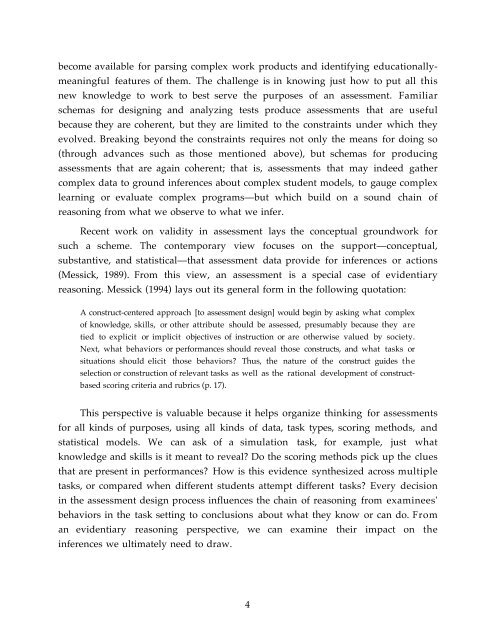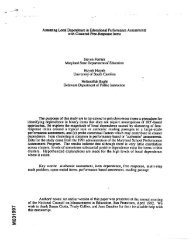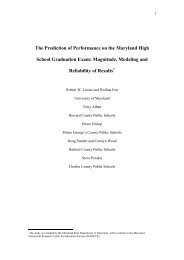A Brief Introduction to Evidence-Centered Design CSE Report 632 ...
A Brief Introduction to Evidence-Centered Design CSE Report 632 ...
A Brief Introduction to Evidence-Centered Design CSE Report 632 ...
You also want an ePaper? Increase the reach of your titles
YUMPU automatically turns print PDFs into web optimized ePapers that Google loves.
ecome available for parsing complex work products and identifying educationallymeaningfulfeatures of them. The challenge is in knowing just how <strong>to</strong> put all thisnew knowledge <strong>to</strong> work <strong>to</strong> best serve the purposes of an assessment. Familiarschemas for designing and analyzing tests produce assessments that are usefulbecause they are coherent, but they are limited <strong>to</strong> the constraints under which theyevolved. Breaking beyond the constraints requires not only the means for doing so(through advances such as those mentioned above), but schemas for producingassessments that are again coherent; that is, assessments that may indeed gathercomplex data <strong>to</strong> ground inferences about complex student models, <strong>to</strong> gauge complexlearning or evaluate complex programs—but which build on a sound chain ofreasoning from what we observe <strong>to</strong> what we infer.Recent work on validity in assessment lays the conceptual groundwork forsuch a scheme. The contemporary view focuses on the support—conceptual,substantive, and statistical—that assessment data provide for inferences or actions(Messick, 1989). From this view, an assessment is a special case of evidentiaryreasoning. Messick (1994) lays out its general form in the following quotation:A construct-centered approach [<strong>to</strong> assessment design] would begin by asking what complexof knowledge, skills, or other attribute should be assessed, presumably because they aretied <strong>to</strong> explicit or implicit objectives of instruction or are otherwise valued by society.Next, what behaviors or performances should reveal those constructs, and what tasks orsituations should elicit those behaviors? Thus, the nature of the construct guides theselection or construction of relevant tasks as well as the rational development of constructbasedscoring criteria and rubrics (p. 17).This perspective is valuable because it helps organize thinking for assessmentsfor all kinds of purposes, using all kinds of data, task types, scoring methods, andstatistical models. We can ask of a simulation task, for example, just whatknowledge and skills is it meant <strong>to</strong> reveal? Do the scoring methods pick up the cluesthat are present in performances? How is this evidence synthesized across multipletasks, or compared when different students attempt different tasks? Every decisionin the assessment design process influences the chain of reasoning from examinees'behaviors in the task setting <strong>to</strong> conclusions about what they know or can do. Froman evidentiary reasoning perspective, we can examine their impact on theinferences we ultimately need <strong>to</strong> draw.4






